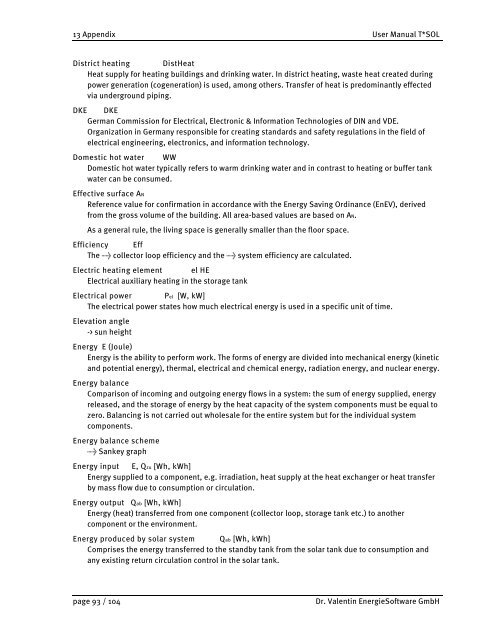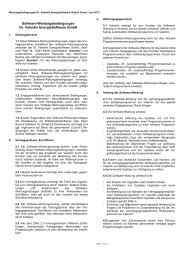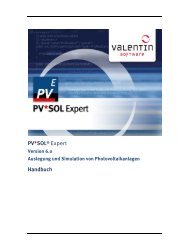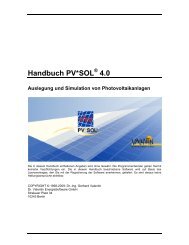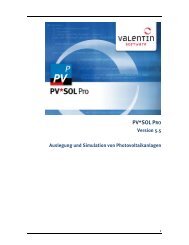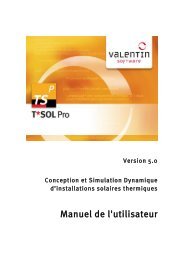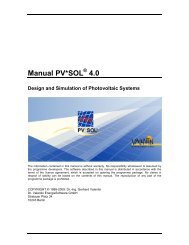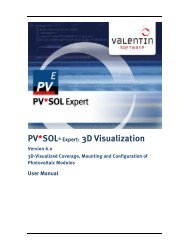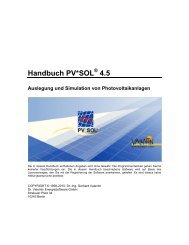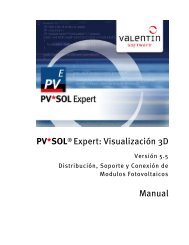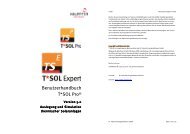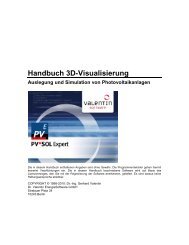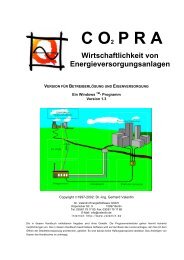Manual T*SOL basic 5.0 - Valentin Software
Manual T*SOL basic 5.0 - Valentin Software
Manual T*SOL basic 5.0 - Valentin Software
Create successful ePaper yourself
Turn your PDF publications into a flip-book with our unique Google optimized e-Paper software.
13 Appendix User <strong>Manual</strong> <strong>T*SOL</strong><br />
District heating DistHeat<br />
Heat supply for heating buildings and drinking water. In district heating, waste heat created during<br />
power generation (cogeneration) is used, among others. Transfer of heat is predominantly effected<br />
via underground piping.<br />
DKE DKE<br />
German Commission for Electrical, Electronic & Information Technologies of DIN and VDE.<br />
Organization in Germany responsible for creating standards and safety regulations in the field of<br />
electrical engineering, electronics, and information technology.<br />
Domestic hot water WW<br />
Domestic hot water typically refers to warm drinking water and in contrast to heating or buffer tank<br />
water can be consumed.<br />
Effective surface AN<br />
Reference value for confirmation in accordance with the Energy Saving Ordinance (EnEV), derived<br />
from the gross volume of the building. All area-based values are based on AN.<br />
As a general rule, the living space is generally smaller than the floor space.<br />
Efficiency Eff<br />
The → collector loop efficiency and the → system efficiency are calculated.<br />
Electric heating element el HE<br />
Electrical auxiliary heating in the storage tank<br />
Electrical power Pel [W, kW]<br />
The electrical power states how much electrical energy is used in a specific unit of time.<br />
Elevation angle<br />
-> sun height<br />
Energy E (Joule)<br />
Energy is the ability to perform work. The forms of energy are divided into mechanical energy (kinetic<br />
and potential energy), thermal, electrical and chemical energy, radiation energy, and nuclear energy.<br />
Energy balance<br />
Comparison of incoming and outgoing energy flows in a system: the sum of energy supplied, energy<br />
released, and the storage of energy by the heat capacity of the system components must be equal to<br />
zero. Balancing is not carried out wholesale for the entire system but for the individual system<br />
components.<br />
Energy balance scheme<br />
→ Sankey graph<br />
Energy input E, Qzu [Wh, kWh]<br />
Energy supplied to a component, e.g. irradiation, heat supply at the heat exchanger or heat transfer<br />
by mass flow due to consumption or circulation.<br />
Energy output Qab [Wh, kWh]<br />
Energy (heat) transferred from one component (collector loop, storage tank etc.) to another<br />
component or the environment.<br />
Energy produced by solar system Qab [Wh, kWh]<br />
Comprises the energy transferred to the standby tank from the solar tank due to consumption and<br />
any existing return circulation control in the solar tank.<br />
page 93 / 104 Dr. <strong>Valentin</strong> Energie<strong>Software</strong> GmbH


